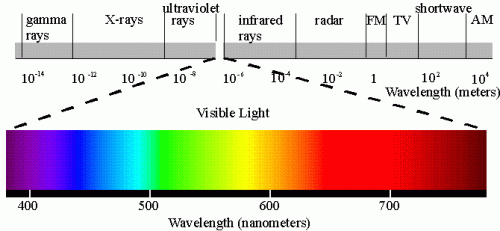Free Thermal Imaging Scan with Home Inspection
The Barrie Home Inspector offers a Free Thermal Imaging Scan with every home inspection. This includes all exterior walls and ceilings of the home. infrared imaging can help you save hundreds, even thousands of dollars per year by detecting moisture, insulation and electrical issues before they pose a bigger risk to your property, fiscal or personal well-being.
Thermal imaging cameras detect radiation in the infrared range of the electromagnetic spectrum (roughly 9,000-14,000 nanometers or 9-14 m) and produce images of that radiation, called thermograms. Since infrared radiation is emitted by all objects above absolute zero according to the black body radiation law, thermography makes it possible to see one’s environment with or without visible illumination.
Thermal Imaging – Infrared Spectrum
Thermal Imaging – Non-Destructive Testing
Thermal imaging is a non-invasive, non-destructive way of evaluating conditions below the surface. Thermal imaging gives a professional home inspector the ability to see beyond the normally visible. The amount of radiation emitted by an object increases with temperature; therefore, thermography allows one to see variations in temperature. When viewed through a thermal imaging camera, warm objects stand out well against cooler backgrounds.
A thermal imaging camera consists of five components: an optic system, detector, amplifier, signal processing, and display. The thermal imaging camera employs a series of mathematical algorithms. Since the camera is only able to see the electromagnetic radiation that is impossible to detect with the human eye, it will build a picture in the viewer and record a visible picture, usually in a JPG format. This picture is included in the report so the client can make an informed decision with all the available information.
During Energy Audits, Infrared Cameras are especially useful when conducting an Infrared Inspection of an attic or hot roof, “thermal by-passes” are located and can be identified for correction to stop the heat loss. Locating Air Infiltration Points – Along with a “Blower Door” the sources of air infiltration and drafts can be pinpointed. Where cold air comes in, and heat escapes; costing you money! The IR camera helps us identify those locations in association with the blower door. Infrared thermal imaging scans can easily verify insulation inside walls and ceilings. The camera will reveal where there is missing, settled, or wet and damaged insulation. As an added benefit, when we scan your home, we can also identify where cold air is coming through your walls.
Thermal Imaging – Moisture & Mould Detection
Mould, mildew and moisture detection are some of the common tasks that thermal imaging is used for during a home inspection. Where there is moisture, there is “evaporative cooling”. With the use of the IR camera, we can identify areas of moisture and potential breeding grounds for biological growth. Thermography or infrared detection is the leading tool in diagnosing water damage. Whether you are concerned about wasted high energy costs, leaks, smells or quality assurance Thermal Imaging can help identify potential problems.
Why Use Thermal Imaging
Inspecting commercial and residential homes using a thermal imaging camera is a powerful and noninvasive means of monitoring and diagnosing the condition of buildings. Thermal imaging technology has become one of the most valuable diagnostic tools for building inspections. A thermal imaging camera can identify problems early, allowing them to be documented and corrected before becoming more serious and more costly to repair.
Thermal imaging is also used for locating and identifying building failures, seeing what the normal eye cannot see. On a thermal image, problems are identified by changing colours. A thermal imaging camera is the one tool that can let you see it all. The Barrie Home Inspector was the first Home Inspector in Simcoe County to offer Thermal Imaging to his clients.

